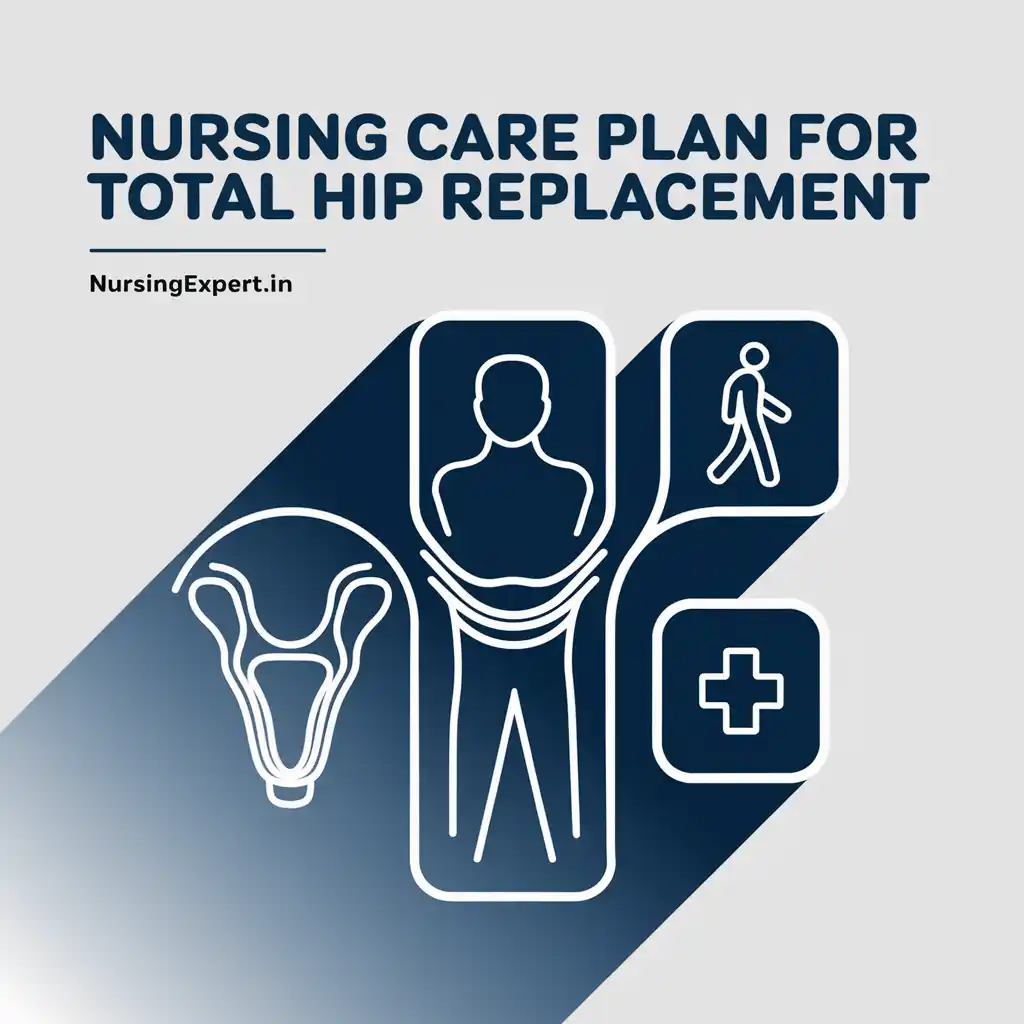Total hip replacement surgery (THR) is a common procedure that relieves pain and restores function in patients with severe hip joint damage. Effective nursing care plays a vital role before and after surgery. A well-structured Total Hip Replacement Nursing Care Plan guides nurses in assessment, intervention, and patient education. This resource also features a sample Total Hip Replacement Nursing Care Plan template and is available as a downloadable PDF for clinical practice and exam preparation.
Thank you for reading this post, don't forget to subscribe!
Introduction
Total hip replacement surgery helps patients with osteoarthritis, rheumatoid arthritis, trauma, or avascular necrosis regain mobility and reduce pain. Nurses play a key role before and after the procedure. A clear, step‑by‑step Total Hip Replacement Nursing Care Plan helps ensure that patients are well prepared, recover quickly, and experience minimal complications.


Understanding Total Hip Replacement Surgery
Definition and Purpose
Total hip replacement involves removing the damaged parts of the hip joint and replacing them with artificial components. The goals are to:
- Relieve pain
- Improve mobility
- Restore joint function
Surgical Impact
The procedure reduces pain and enhances quality of life. However, it also brings challenges:
- Surgical wounds require careful care.
- Patients face risks such as infection and deep vein thrombosis (DVT).
- Early mobilization is essential for a smooth recovery.
Preoperative Considerations
Before surgery, nursing care focuses on detailed assessments and preparing patients both physically and mentally.
Assessment and Preparation
- Medical History:
Review comorbidities, allergies, current medications, and previous surgeries. - Baseline Data:
Evaluate pain levels, mobility, and vital signs. - Diagnostic Testing:
Ensure all necessary labs and imaging studies are complete. - Informed Consent:
Confirm that the patient understands the procedure and has signed the consent form.
Patient Education and Emotional Support
- Explain the Procedure:
Use clear language to describe what happens during surgery. - Preoperative Instructions:
Provide guidelines on fasting, medication adjustments, and arrival times. - Emotional Support:
Address concerns and reduce anxiety with one-on-one counseling. - Documentation:
Record all assessments and patient responses to build trust and ensure clarity.
Postoperative Considerations
After surgery, nursing care shifts to monitoring, managing pain, and promoting early recovery.
Monitoring and Early Mobilization
- Vital Signs:
Regularly check heart rate, blood pressure, and temperature. - Early Ambulation:
Encourage gentle movement and physical therapy to reduce DVT risk. - Respiratory Support:
Monitor breathing, especially in patients with decreased mobility.
Wound and Pain Management
- Wound Care:
Use sterile techniques during dressing changes and inspect the site for infection. - Pain Control:
Administer prescribed analgesics and use non-drug methods like cold compresses. - Nutrition and Fluids:
Support recovery with proper hydration and diet. - Education:
Teach patients about signs of complications and care of the incision.
Pathophysiology and Etiology
Total hip replacement surgery becomes necessary when the hip joint suffers severe damage due to:
- Osteoarthritis:
Wear and tear cause joint cartilage to break down. - Rheumatoid Arthritis:
Inflammation damages the joint. - Trauma:
Severe fractures or injuries disrupt joint integrity. - Avascular Necrosis:
Reduced blood supply causes bone death.
The procedure replaces the damaged joint with prosthetic parts, restoring function and alleviating pain.
Signs and Symptoms
Before surgery, patients often experience:
- Severe Joint Pain:
Persistent pain that interferes with daily activities. - Limited Mobility:
Reduced range of motion in the affected hip. - Swelling and Stiffness:
Inflammation around the joint.
After surgery, watch for:
- Postoperative Pain:
Pain at the incision site or deep in the joint. - Wound Changes:
Redness, swelling, or discharge. - Reduced Mobility:
Difficulty moving the leg, which may signal complications like DVT.
Nursing Diagnoses
Based on patient assessments, common nursing diagnoses include:
- Acute Pain:
From surgical incision and tissue trauma. - Impaired Physical Mobility:
Due to postoperative weakness and discomfort. - Risk for Infection:
Because of surgical intervention and wound exposure. - Risk for Deep Vein Thrombosis (DVT):
Owing to immobility and surgical stress. - Deficient Knowledge:
About postoperative care and self-management. - Anxiety:
Due to fear of surgery and uncertainty about recovery.
Nursing Interventions
Nursing interventions support patient recovery by targeting each diagnosis. These actions must be clear, precise, and timely.
Key Interventions with Rationale
- Pain Management:
- Intervention: Administer prescribed analgesics and use cold compresses.
- Rationale: Effective pain relief enhances comfort and supports early mobility.
- Wound Care:
- Intervention: Use sterile techniques during dressing changes and monitor the incision site.
- Rationale: Proper care prevents infection and promotes healing.
- Vital Signs Monitoring:
- Intervention: Check heart rate, blood pressure, and temperature regularly.
- Rationale: Early detection of complications allows for prompt intervention.
- Promote Early Mobilization:
- Intervention: Encourage gentle ambulation and support physical therapy sessions.
- Rationale: Early movement reduces the risk of DVT and speeds recovery.
- Fluid and Nutritional Support:
- Intervention: Monitor fluid intake/output and coordinate with dietitians.
- Rationale: Adequate nutrition and hydration are key to wound healing.
- Patient Education:
- Intervention: Provide clear instructions on wound care, medication use, and activity restrictions.
- Rationale: Well-informed patients follow guidelines better and recover more successfully.
- Emotional Support:
- Intervention: Offer counseling and stress reduction techniques.
- Rationale: Reducing anxiety improves overall recovery and patient cooperation.
Nursing Management Strategies
A well-organized management strategy keeps patient care efficient and safe throughout the surgical process.
Initial Assessment
- Document Baseline Data:
Record pain levels, mobility, wound condition, and vital signs. - Establish Priorities:
Identify critical issues like pain control and infection prevention.
Continuous Monitoring and Reassessment
- Regular Rechecks:
Monitor vital signs and wound status frequently. - Adjust Interventions:
Modify the care plan based on patient progress and lab results. - Documentation:
Keep detailed records of all observations and interventions.
Timely Interventions
- Prompt Medication Administration:
Ensure pain control and infection prevention measures start as soon as possible. - Early Mobilization:
Encourage movement as soon as the patient is stable. - Prepare for Complications:
Be ready to intervene if signs of DVT or infection arise.
Patient-Centered Education
- Customize Teaching:
Adapt instructions to the patient’s needs and understanding. - Use Visual Aids:
Provide diagrams, brochures, and written materials. - Follow-Up:
Schedule regular discussions to reinforce learning and adjust care practices.
Interdisciplinary Collaboration
- Team Approach:
Work with surgeons, physical therapists, dietitians, pharmacists, and patient educators. - Effective Communication:
Share updates and coordinate care through regular meetings and clear documentation.
Patient and Family Education
Educating patients and families is crucial for a smooth recovery after total hip replacement.
Key Educational Points
- Understanding the Surgery:
Explain the procedure, recovery timeline, and expected outcomes. - Wound Care:
Teach proper techniques to keep the incision clean and dry. - Medication Management:
Explain the purpose of each medication and the importance of adherence. - Activity Guidelines:
Provide clear instructions for safe mobilization and exercise. - Recognizing Complications:
Instruct on symptoms like increased pain, redness, fever, or breathing difficulties. - Diet and Hydration:
Offer advice on nutrition that supports healing and overall health.
Communication Strategies
- One-on-One Sessions:
Conduct personalized education meetings. - Printed Materials:
Distribute brochures and handouts. - Interactive Discussions:
Encourage questions and check for understanding. - Family Involvement:
Include family members to support care at home.
Interdisciplinary Collaboration
A team approach improves patient outcomes in total hip replacement surgery.
Key Team Members
- Surgeons:
Oversee the surgical procedure and postoperative care. - Physical Therapists:
Design and supervise rehabilitation programs. - Dietitians:
Provide nutritional support tailored to recovery needs. - Pharmacists:
Manage medications and monitor for interactions. - Patient Educators:
Reinforce self-care practices and address patient queries. - Social Workers:
Help patients access community resources and support services.
Enhancing Communication
- Regular Team Meetings:
Discuss patient progress and adjust care plans. - Clear Documentation:
Maintain up-to-date records accessible by all team members. - Coordinated Decision-Making:
Share vital information to ensure smooth transitions from acute care to home recovery.
Sample Nursing Care Plan
Below is a sample care plan template tailored for Total Hip Replacement Surgery. This structured approach helps document assessments, interventions, and outcomes clearly.
| Assessment | Nursing Diagnosis | Goal/Expected Outcome | Interventions/Planning | Implementation | Rationale | Evaluation |
|---|---|---|---|---|---|---|
| Subjective Data: • Patient reports moderate pain (6/10) at the incision site and difficulty moving the affected limb. Objective Data: • Incision appears clean; limited range of motion; vital signs are stable. | Acute Pain Related to surgical incision and tissue trauma. | Short-Term: • Reduce pain to 3/10 within 1 hour. Long-Term: • Patient reports manageable pain and improved mobility. | – Administer prescribed analgesics. – Encourage gentle range-of-motion exercises. – Use non-pharmacological pain relief (e.g., cold compresses). | – Provide pain medication as scheduled. – Monitor pain every 30 minutes. – Assist with exercises during recovery. | – Effective pain management supports early mobilization and rehabilitation. | – Patient reports decreased pain; increased mobility; pain score reduced to desired level. |
| Subjective Data: • Patient expresses concern about infection risk at the surgical site. Objective Data: • Slight redness noted; temperature is normal; wound is intact. | Risk for Infection Related to surgical intervention and wound exposure. | Short-Term: • Maintain a clean, intact surgical site within 24 hours. Long-Term: • Patient remains infection-free during recovery. | – Use aseptic techniques during dressing changes. – Monitor the wound regularly for signs of infection. – Educate patient on proper wound care. | – Perform dressing changes using sterile methods. – Document wound status every 4 hours. | – Proper wound care prevents infection and promotes healing. | – Wound remains clean; no signs of infection observed. |
| Subjective Data: • Patient is uncertain about self-care and activity restrictions post-surgery. Objective Data: • Patient asks questions about diet, medication, and mobility; appears anxious. | Deficient Knowledge Related to lack of information about postoperative care. | Short-Term: • Patient verbalizes key self-care strategies within 24 hours. Long-Term: • Patient adheres to postoperative guidelines and demonstrates effective self-management. | – Develop an education plan on medication adherence, dietary guidelines, wound care, and activity restrictions. – Provide written and visual educational materials. | – Conduct individualized teaching sessions. – Distribute brochures and schedule follow-up discussions. | – Education empowers patients to manage their recovery and prevents complications. | – Patient demonstrates understanding; self-care practices are consistent; follow-up confirms adherence. |
This template is a key component of the Total Hip Replacement Nursing Care Plan. It serves as a reliable tool to track patient progress, modify interventions, and achieve optimal recovery outcomes.
Downloadable PDF
For quick reference and to support your clinical practice, a complete Total Hip Replacement Nursing Care Plan PDF is available for download. This resource compiles detailed care strategies, nursing diagnoses, and the sample 7‑column care plan template in one document.
📥 Download Total Hip Replacement Nursing Care Plan PDF
Frequently Asked Questions (FAQs)
What is total hip replacement surgery?
Total hip replacement surgery involves removing damaged parts of the hip joint and replacing them with artificial components to relieve pain and restore mobility.
What are common postoperative symptoms?
Patients may experience pain, swelling, limited mobility, and a risk of infection at the surgical site.
How is pain managed after hip replacement?
Pain management includes prescribed analgesics, cold compresses, and early mobilization to reduce discomfort and support rehabilitation.
Why is patient education important in hip replacement recovery?
Education on wound care, medication adherence, and safe activity guidelines helps patients prevent complications and achieve a smooth recovery.
How do nurses evaluate the success of a hip replacement care plan?
Success is measured by stable vital signs, reduced pain levels, improved mobility, and patient adherence to self-care practices.
Conclusion
A comprehensive nursing care plan is essential for the successful recovery of patients undergoing total hip replacement surgery. This Total Hip Replacement Nursing Care Plan offers clear, actionable steps—from thorough preoperative assessment and patient education to diligent postoperative monitoring and early mobilization. With structured interventions and continuous evaluation, nurses can effectively manage pain, prevent complications, and promote swift recovery.
Key elements include:
- Detailed Assessment: Recording baseline data on pain, mobility, and wound status.
- Targeted Interventions: Using pain control, aseptic techniques, and early mobilization to support healing.
- Patient Education: Empowering patients with clear instructions on self-care, activity restrictions, and warning signs.
- Team Collaboration: Working with an interdisciplinary team to deliver comprehensive, patient-centered care.
This guide is designed to be an engaging, NLP-friendly resource for clinical practice and exam preparation. Use it to enhance your knowledge, improve patient outcomes, and maintain a high standard of care in your practice.
References and Sources
- Mayo Clinic. (2023). Total Hip Replacement: Overview, Risks, and Recovery. Retrieved from https://www.mayoclinic.org/tests-procedures/hip-replacement
- MedlinePlus. (2023). Hip Replacement Surgery. Retrieved from https://medlineplus.gov/hipreplacementsurgery.html
- NANDA International. (2022). NANDA Nursing Diagnoses: Definitions and Classifications. Retrieved from https://www.nanda.org/
- American Academy of Orthopaedic Surgeons. (2023). Hip Replacement Recovery Guidelines. Retrieved from https://www.aaos.org
- Centers for Disease Control and Prevention (CDC). (2023). Postoperative Care and Infection Prevention. Retrieved from https://www.cdc.gov


